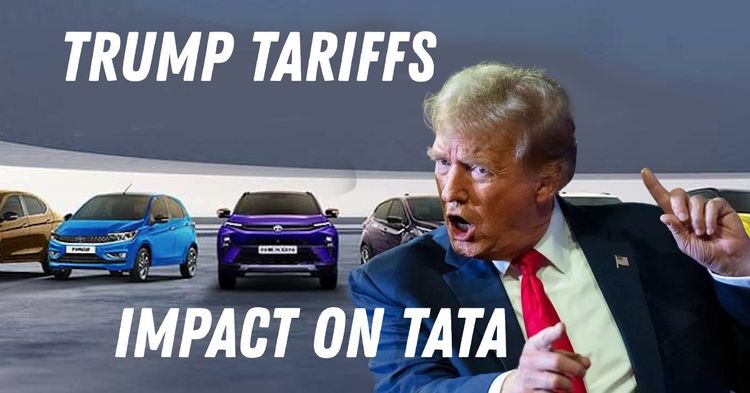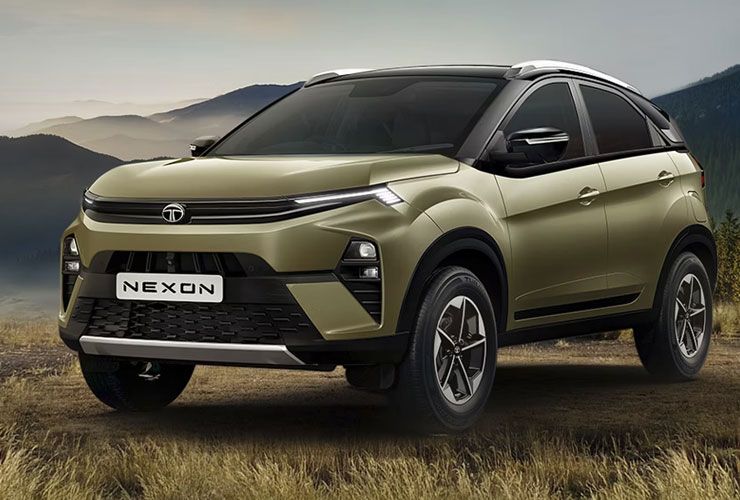How Trump's Tariffs Could Reshape Tata Motors' Global and Indian Business (And Stock Price!)


Tata Motors, one of India’s most prominent automotive companies, has found itself at the centre of a global trade storm after US President Donald Trump announced a 25% tariff on imported cars and auto parts led to Tata Motors share price falling 7% on that very day itself.
This policy, effective April 2025, has sent shockwaves through the global automotive industry, with Tata Motors being one of the hardest-hit companies due to its reliance on Jaguar Land Rover (JLR), its luxury subsidiary. While the immediate focus has been on JLR’s exposure to the US market, the ripple effects of these tariffs could also significantly impact Tata Motors' operations in India, including its investment strategies, product pipeline, and consumer offerings.

JLR is a cornerstone of Tata Motors’ global business. The luxury brand accounted for around 71% of Tata Motors’ consolidated revenue in FY24, with the US being one of its most critical markets. In FY24, 23% of JLR’s sales came from the US, and this figure rose to 33% in the first nine months of FY25. The new tariffs will directly affect JLR vehicles manufactured in the UK and EU that are imported into the United States.
The financial implications are severe. Analysts estimate that absorbing even part of the tariff burden could reduce JLR’s operating margins by up to 200 basis points. This could derail Tata Motors’ plans to make JLR debt-free by FY25 and achieve a 10% EBIT margin target. In response, JLR may have to consider price hikes or cost-cutting measures—strategies that could hurt sales volumes or delay profitability improvements.
While JLR’s challenges are global in scope, their impact will inevitably trickle down to Tata Motors’ Indian business in several ways:
Tata Motors has already announced a significant ₹43,000 crore investment plan for FY25, with ₹35,000 crore allocated to JLR and ₹8,000 crore reserved for its Indian operations. However, with JLR facing potential revenue shortfalls due to tariffs, there could be pressure to reallocate funds towards mitigating losses in the US market or even setting up a manufacturing facility in America. This could delay planned investments in India for product development and infrastructure expansion.
Tata Motors has an aggressive product pipeline for India, particularly in electric vehicles (EVs). Upcoming launches include models like the Harrier EV (June 2025), Sierra EV (August 2025), and Punch EV (September 2025). However, any financial strain on the parent company might lead to delays or reduced marketing budgets for these launches. Additionally, if funds are diverted to address JLR’s challenges, Tata’s ability to maintain its leadership in India’s EV market could be compromised.
Indian consumers may face indirect consequences as well:
Higher Prices: If Tata Motors reallocates resources globally or faces increased costs due to supply chain disruptions caused by tariffs on auto parts exported from India to the US (valued at $6.79 billion in FY24), it might pass these costs onto Indian buyers.
Delayed Innovations: Financial constraints could slow down the rollout of advanced technologies and new models in India.

The tariffs create a strategic dilemma for Tata Motors—should it prioritise addressing JLR’s challenges in the US or continue focusing on strengthening its position in India? Both options come with trade-offs:
Focus Area Pros Cons
Investing in JLR/US - Protects revenue from a key market; long-term stability through local manufacturing High capital expenditure; delays investments in India
Prioritising India - Strengthens domestic market leadership; accelerates EV adoption Risks losing market share and profitability in critical global markets
One potential solution for mitigating tariff impacts is setting up a manufacturing facility in the US. While this would allow JLR to bypass import duties, it comes with significant challenges:
• High Costs: Establishing a plant could take two years and require substantial capital investment.
• Operational Risks: Managing production across multiple geographies adds complexity.
• Dollar Appreciation: A stronger dollar could increase costs further.
Alternatively, Tata Motors might explore diversifying its export markets for both JLR vehicles and Indian-made auto components. However, this would require building new trade relationships and adapting supply chains—processes that take time.
The Broader Impact on India’s Auto Industry
The US tariffs don’t just affect Tata Motors but also have implications for India’s broader automotive sector:
• Auto Component Exports: With $6.79 billion worth of auto parts exported from India to the US annually, suppliers like Bharat Forge and Sona BLW Precision Forgings are also vulnerable.
• Supply Chain Disruptions: Increased input costs for US automakers could reduce demand for Indian components.
• Competitiveness Issues: If Tata Motors shifts investments abroad or delays domestic projects, it may lose ground to competitors like Mahindra & Mahindra or Hyundai in India.

The imposition of US tariffs has created significant challenges for Tata Motors at both global and domestic levels. While JLR faces immediate profitability concerns due to its dependence on the American market, the ripple effects could disrupt Tata Motors’ ambitious plans for India—particularly its leadership position in EVs and ongoing investments.
To navigate these challenges effectively, Tata Motors will need to strike a delicate balance between addressing short-term pressures from tariffs and maintaining its long-term growth trajectory in India. Whether through strategic cost-cutting measures, exploring alternative markets, or accelerating domestic innovation efforts, how Tata responds will shape not only its future but also that of India’s automotive industry as a whole.